Someone rings the handbell in the workshops. New order coming in! A new plane is soon going be emerging, piece by piece, from every workbench.
The order passes through the fine sieve of the IT system. Printers are already warm. The manufacturing orders – « OF’s » for « Ordre de Fabrication » – are now sprinkling all over the Darois factory. There’s thousands of those sheets of paper that itemize the workflow specific to each workshop, each team and each employee. It’s raining OF’s and the wooden parts quickly grow and assemble to shape the most famous part of the DR401: its silhouette.
Of course, it’s only natural that wood is usually perceived as the star material in a Robin, but let’s not forget it could never reach the sky without metal.
So let’s follow that thought and that pack of sheets going through the assembly workshop towards a spiral staircase.
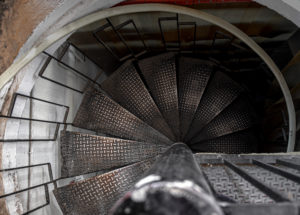
So let’s follow that thought and that pack of sheets going through the assembly workshop towards a spiral staircase. Carried by Didier’s hands, the pack goes down the stairs, then through the plastic curtain and that’s exactly when the ruckus reaches the ears: cutting and slicing and bending and milling and sawing and drilling and hallmarking can be heard all at once. There’s no doubt we are now in the CEAPR metal workshop.
The pack of OF’s passes by the storage magazine, the control office and through the workshop, weaving through the hydraulic presses, the folding machines and the roll benders. There’s a smell of oil and welding in the air, sparking all kinds of questions. The pack of sheets goes up a few stairs to get to the foreman’s office. And the foreman, as it is, is precisely Didier.
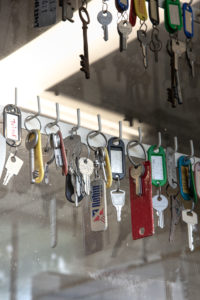
There’s two or three generations of keys in his office, hanging there on the wall, opening all sorts of doors and triggering all kinds of machinery. The shelves are overflowing with blueprints and archives. In this very room, each OF multiplies again, miraculously, through CEAPR’s own IT system: the nose gear, for instance, consists of three distinct manufacturing orders including the « box », « leg » and « lock pin ». Three OF’s that decompose further into dozens of operations and so on. There’s usually five of six hundred OF’s at a time, not only to contribute to the planes that are being assembled at the moment, but first and foremost to provide the spare parts for the Robins all over the world.
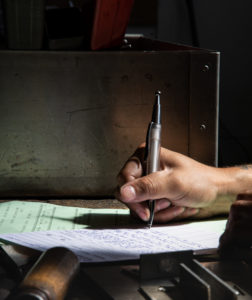
It’s safe to say nobody can indulge into idleness.
The manufacturing orders leave the foreman’s office one by one, in the hands of his men. Almost every one of them can do almost everything on almost any machine.
Let’s follow a specific OF if you will. This one, for example, going towards the back of the workshops in the hands of Dimitri, Didier’s right-hand man. Dimitri slows down near a colossal oven that kind of looks like an elevator in a forgotten palace. Dimitri turns to the right whilst checking the OF and stops in front of a huge cage in which hundreds of long tubes of various sizes and alloys are stored. That tube magazine makes quite an impression, like a gigantic organ was overturned in an oversized bird cage.

Dimitri chooses a few tubes then conscientiously marks his measurements before proceeding to saw the tube into a dozen portions. As the tube gets smaller and smaller, the pace is set by the outbursts of sparks between each portion made. Dimitri ends up with a set of twelve tubes to be deburred and degreased before the OF ends up in Abdel’s hands to be bevelled « wolf-mouth » style.

Then Abdel walks over to the other side of the workshop, passing by the foreman’s office and the welding stations -where he leaves the tubes – then following the shelves crowded with machined parts and templates still hot from the hammer blows… He walks all the way down to the heavy lathing and milling machines, Bouboule’s territory. Bouboule is Bruno, and Bruno, with his thirty-three years in the metal workshop, never has a problem with anything. He only has solutions. So Bouboule merely glances at the OF and before any milling or lathing takes place, he has to go for the angle iron plates to slice some up. Once that’s done, he comes back to the lathing and milling zone to lathe and mille, and then drills openings for screws and bolts on the baseplates he just fashioned. He hardly ever looked at the OF in the process, just here and there for the sake of habits. He then proceeds to head for another machine close by, to « guillotine » sheets of metal into eight separate parts, then roll-bends those to get the eight halves of the four bobbin supports the OF is asking for. His swift pace and light step then leads him to Sokal and his hydraulic press that sort of resembles a pagan mausoleum. Sokal stamps the half-supports until he finds the right « angle » of bulging before sending them along with the tubes and baseplates to the welding stations. The OF lands on Tataye’s workbench. Tataye seems to know it by heart already. He flips through the metal rods then draws a few with a wide gesture like they were arrows from a quiver.


He puts down his mask and immediately starts welding the eight parts into four bobbin-supports that he then welds to the « wolf-mouthed » tubes, all that in an Eiffel-towery-fashion. The « barrel » of his TIG gun produces an hypnotic sizzling star from which a thin line of blue smoke rise like that of a cigarette. Components assemble quite rapidly, the structure appears slowly. Tataye finishes up with the baseplates that Bouboule prepared and that will be used to attach this impressive engine-mount to the rest of the DR401. That mount will have to support not only the vertical weight of the two-pounds-per-horse-engine but also the phenomenal traction that is supposed to take the plane along with the engine… Let’s not forget of course the torsion effort that inflicts the propeller attached to the engine’s 120, 160, 180 or 200 horses. That is why the engine-mount has to be, every time without exception, a monument of precision. One has to make every last gram count.
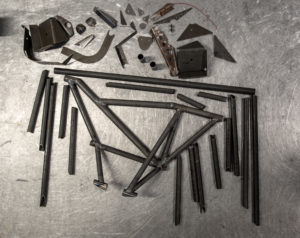
Every single part of an engine-mount, as you can see to itemize every single operation would have taken about five pages of this article…
So there’s an OF fully done, that’s going back to Didier’s office whilst the engine-mount is headed to control, then painting, then control again before going in stock at « upstairs’ » disposition.
Meanwhile, in his office, Didier is perusing the priorities the IT system has set and cross-matches it with what he knows about the schedules and specialities of each of his men. A handful of OF’s are then given to Dimitri who gets out of the office and slaloms once again from Laurent to Eric, and from Patrick to Antoine. With their respective OF’s in hand, all of them immediately start for their respective tasks, moving towards the fluffers, the tube benders and other band-saws.


Down here, the old french-made machines have friendly faces, loyal looks so to speak. They sometimes look surprised that they’ve been sharing the workshop for about forty or fifty years with men that always look composed, kind of cool, travelling from one end of the shop to the other, amidst the bursts of sparks and hanging cables with the same ease they would demonstrate in their own living-room. Some of those men have actually been here longer than the machines, others are more recent than the thoroughly-up-to-date IT system. Mixing generations is the way things have always been done around here, it’s simply the best way to let the know-how flow from one to the next…



Anyway benders can still be heard bending, drillers drilling and jokers joking about things one cannot understand if one isn’t a metal-worker or a boilermaker or a coppersmith or even a good old village blacksmith. In the meantime, another OF got out of the office with Patrick who just cut a much thicker kind of sheet, using the giant « guillotine » that must be a DR 401-long and weigh about three or four of those. The metal sheets he takes into the routing-machine-booth are covered with hand-marked measurements. He operates manually the massive articulated arm to make it cut fine round angles like he was manufacturing lace for fine lingerie… Except he’s doing « fine-metalerie ».
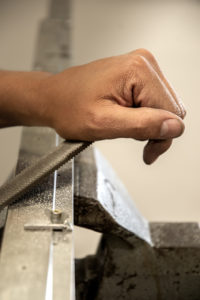
This thorough workmanship results in six separate parts, six meticulously rounded flat ribs that are sent to Sokal for stamping. Meanwhile, at the other end of the workshop, Antoine is carefully working out the bending of a large metal sheet on the big « Bombled ».
This trapezoidal bending angle is easily recognizable: it’s the fuel-tank enveloppe.

All parts of the fuel tank
The six ribs will soon be riveted in parallel lines by Nico. Round openings have been left in each rib to allow the fuel to go from one side to the other without putting the aircraft’s balance at risk in case of a sudden turn. The tank weighs only about twelve pounds but it can stock up to 109 liters, which is about one eighth of the DR401’s total tare weight.
Now Nico has to weld the enveloppe along a single horizontal line and send it to control, painting, control again… you know the drill by now.


So let’s stop right there for a moment. Right there in the middle of this ballet of OF’s and workers, rough materials and refined bits of metal. Let’s listen to the heartbeat produced by all those hands, hammers and machines beating on steel as if they were looking for the right sound on a cymbal. Let’s have a look at those workbenches that show stratified know-how. There’s so many traces of tools there. Tools that carved or burnt the table, that took wood dust along with metal dust.
All this hard work, every day, is done by all those hands to transform sheets and tubes into rods, boxes, pipes, wing flaps, mounts, supports, brackets, silencers, exhausts, dashboards, tanks, fire walls, canopy and seat structures, deflectors, gears, rudders, handles and all types of control sticks… and all that, of course, multiplied by the number of Robin models that came out along the years and the many, many different motorisations.
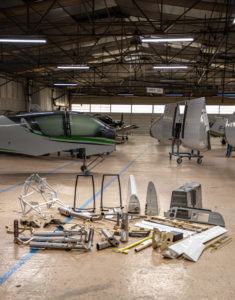
Informal gathering of metal pieces at the coffee break.
To keep the older Robins flying – some of them are actually over fifty years old now – the metal workshop has to keep up this production throughput to go on providing the spare parts indispensable to those longevity records. A great responsibility, and quite the indication of aimed-at quality.
Here, the machines are so immense, occupy the space between floor and ceiling so fully, that one could believe they’re the pillars of this workshop.
But by no means is that true. The only pillars here, are men.
Didier, the foreman, actually thinks that every last one of his men benefits from the highly-demanding environment of aeronautics and is fully aware of the human quality of that workshop in particular. Where everything seems so human and mechanical at the same time.
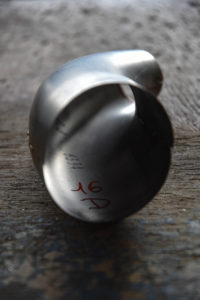 From a distance, every part seems to have been machine-made, like it just came out of a production chain. But here, machines are only tools in the hands of men. And up close, one can actually see the minuscule irregularities that reveal unmistakably the specific ways of the human eyes and hands.
From a distance, every part seems to have been machine-made, like it just came out of a production chain. But here, machines are only tools in the hands of men. And up close, one can actually see the minuscule irregularities that reveal unmistakably the specific ways of the human eyes and hands.
Maybe those hands, guided by those eyes, are the reason those planes are so lively. Wood makes them float on air, but oddly enough, it’s all that metal that allows them to take off. The DR401 can only take shape through teamwork. It can only get closer and closer to perfection if the Robin and CEAPR? workshops manage to combine forces so as to harmonise wood and metal to the highest degree.
The newborn that was ordered this morning, will see the light after many days like the one we witnessed today. That is after many of these races where the IT system passes on the baton to the « fully-equipped » robinites.
But hold that thought… another is bell is ringing, and this time it’s ringing the end of the day. The workshop slowly empties, the focused looks on every face turns into jovial ones with the last few private jokes. Somebody turns the neons off. Soon enough, there’s only the dripping sound of the ruban saw and the light in Didier’s office to let us know time hasn’t stopped. It’s been sixty-three years, and it’s just a start.
Tomorrow at eight, the great ballet will have already picked up where it left it tonight.
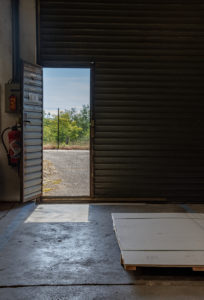



Leave a comment